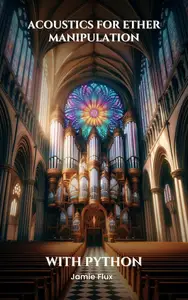
Free Download Acoustics for Ether Manipulation (Mathematical Foundations of Quantum Field Theory) by Jamie Flux
English | September 21, 2024 | ISBN: N/A | ASIN: B0DHQBKJ9P | 181 pages | PDF | 3.83 Mb
Cathedral organs were designed to playfrequencies inaudible to human ears. Lets investigate through the lens of Quantum Field Theory.
Key Features:
- An advanced guide to using church organs and architectural acoustics for quantum field manipulation.
- Comprehensive chapters with Python code, enabling practical application of complex theories.
- In-depth analysis of the intersection between acoustics and quantum mechanics.
What You'll Learn:
1. Explore quantum harmonics within the resonant structures of pipe organs using Python.
2. Apply the wave equation to model acoustic propagation in organ architectures.
3. Delve into the formation and representation of cymatic patterns on resonant surfaces.
4. Discover how acoustic vibrations influence and modulate quantum fields.
5. Calculate resonance frequencies in architectural spaces using advanced eigenvalue problems.
6. Decompose organ sounds into harmonic components via Fourier analysis.
7. Use perturbation theory to describe sound-wave interactions with quantum fields.
8. Design cymatic patterns into window structures for innovative waveguide solutions.
9. Study nonlinear wave equations in complex cymatic architectures.
10. Understand quantum coherence in macroscopic sound waves using density matrices.
11. Derive interaction Hamiltonians that unite acoustic phonons with quantum fields.
12. Apply symmetry operations to cymatic designs using group theory.
13. Examine the acoustic Casimir effect within confined architectural spaces.
14. Modulate electron wavefunctions with time-dependent acoustic fields.
15. Investigate quantized vortices in cymatic patterns using the Gross-Pitaevskii equation.
16. Quantize fields within organ pipe cavities through canonical methods.
17. Explore the potential for quantum entanglement via synchronized acoustic fields.
18. Model photon-phonon interactions in architecturally structured windows.
19. Analyze anharmonic effects in organ acoustics using perturbation methods.
20. Relate electromagnetic gauge fields to sound wave potentials.
21. Utilize topology to comprehend sound propagation in complex designs.
22. Formulate acoustic analogs to Dirac fermions for advanced sound systems.
23. Design acoustic metamaterials for controlling field interactions.
24. Determine quantized energy levels within cymatic structures using boundary quantization.
25. Theorize acoustic black holes and explore Hawking-like emissions in sound waves.
26. Develop effective field theories for large-scale quantum phenomena in acoustics.
27. Model the tunneling of sound waves through acoustic barriers.
28. Apply superposition principles to analyze complex sound fields.
29. Employ path integral formulations to model sound wave propagation.
30. Utilize Lie algebras to depict continuous symmetries in cymatic patterns.
Code:
Bitte
Anmelden
oder
Registrieren
um Code Inhalt zu sehen!